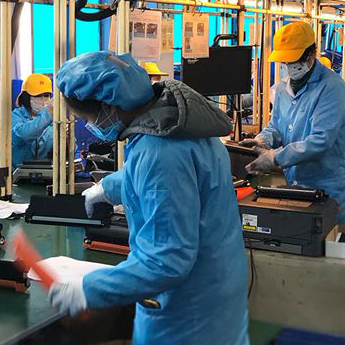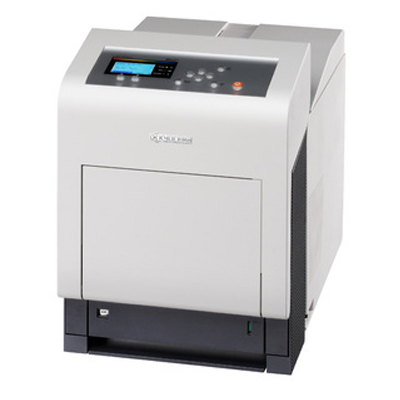MPS Compliant – Analysis of Printer/Copier Models
Managed Print Services is no longer the domain of the major dealers. MPS is quickly expanding as an offering by MSP’s and smaller companies. Such trend is large enough to justify Nubeprint to publish its results and analysis of the printer and copier models from the perspective of their suitability in an MPS portfolio.
While major players already know the risks of MPS (this risk can be summarized by the fact that little or no control of the variable costs drive to significant loss of profitability and poor quality service to customers), the smaller players are at serious risk of making huge mistakes that may ruin their reputation among their customers and seriously impact their profitability long term.
The Nubeprint Report measures the most frequent network printer and copier models as to which extent they are MPS ready. In the July 2013 release we focused on the impact that the compliance has on the profitability of the MPS service provider (dealer, MSP or any other), with specific attention to the amount of the supply that is wasted every time the cartridge is replaced.
In today’s edition we include data about the printing patterns in the office. The analysis is fully independent of printer and copier manufacturers and is based on actual data from printer models in a live MPS environment.
The graphs are self-explanatory. Narratives are provided just as guidance for a better understanding of the graphs.
This report provides relevant information to printer and copier manufacturers and vendors, supplies manufacturers or remanufacturers, MPS service providers, future MPS providers, end- customers and in general anyone interested in getting inside information of the MPS business.
The Nubeprint Report is issued bi-annual (January and July) in order to facilitate the most updated information and the market trend.
Any related question regarding the Nubeprint Report can be addressed to info@Nubeprint.com.
Scope and limitations of the analysis:
The analysis focuses on the ability of the printer to provide sufficient data so that an advanced MPS technology can potentially drive the services. The quality of the data provided is ignored on purpose. The analysis works under the assumption that the data is homogenous and accurate.
The analysis does not differentiate the type of device as long as the document output is homogeneous: an office printer or copier, no matter what its size is (letter, A4, A3, A0…). As a consequence, the Report includes laser printer, inkjet and solid ink printers, ribbon (including label printers) or large format printers (LFP).
This new edition includes products from 8% more manufacturers, up to 39. The LFP models are from four different manufacturers. The Ribbon printers belong to 11 different manufacturers.
Though the number of LFP and Ribbon equipment is small compared to the office printers and copiers, their management is a real burden for the customer. The MPS service provider demand to handle these devices is high, as this is the way for them to gain new customer and protect existing ones by being the sole service provider for printing equipment in each account.
A special part of the Nubeprint Report is dedicated to analyze how the printers and copiers are being used. The scope being to identify to which extent the need for more printing resources is there or not, the study is conducted over 8,125 printers and copiers located in a diversity of geographies and companies of all sizes.
The case study has used a yield management MPS tool (Nubeprint CPS) to accurately obtain the results.

Population
The analysis was conducted with 1,900 document output device models selected among the most commonly found in the office market, expanding the previous edition by 300 models. New manufacturers in the list are: Copystar, Imagistics and Intec.
The models analyzed are classified in 6 different types: monochrome printers, color printers, monochrome MFP (multifunctional including copiers), color MFP, large format printers (LFP) and ribbon printers. 57% of the population analyzed is MFP while 38% is printer, 4% is LFP and 1% is ribbon. Overall 46% is color and the remaining 54% is monochrome, excluding LFP and ribbon.

Market Compliance
Overall
The population analyzed shows that 34% of the models are full MPS compliant, while 30% have some major limitations, including 4% that are not compliant, meaning not being appropriate for MPS. Non-compliant models remain exceptional. But as the number of models included in the analysis grows so does the list of manufacturers that have models that are not MPS compliant.
28% of the manufacturers have models that are not feasible for MPS. In total, 69% of the manufacturers do carry models that are either not MPS compliant, either show major compliance issues (see graph on page 7). LFP and ribbon printers are the biggest contributors to non-compliant MPS printers, as can be deducted from the following graph .

66% of models do require an advanced MPS management technology to compensate for their lack of capability in MPS. In other words, 2 out of 3 of the models analyzed do expose the MPS service provider to risks in terms of the quality of the service, profitability of the business and therefore competitiveness. These models experience significant limitations and inefficiencies in terms of identifying with accuracy and their needs of supplies and service, and the amount of resources to manage them. As a consequence, they are not suitable for auto-fulfillment and do require exceptional predictability technology if to be a part of an MPS offer.
If you have read Nubeprint Report past editions, you will certainly have noticed that the percentage of models that are not suitable for MPS has been fluctuating very little between 66% and 71%. The printer and copier models that are included in the analysis in each edition are not making any difference in terms of evaluating the MPS compliance of the overall install base in the market.

Per type of device:
The limitations found per type of device make the single function printers as the most MPS friendly devices: overall 44% are full MPS ready, compared to 29% of the color and monochrome MFP.
Color devices (both MFP and printer) in general have the highest level of compliance with just 14% showing major limitations. Monochrome MFP gets the worst results in office printing equipment (46% showing major issues in MPS). In general, 41% of monochrome printers and copiers show major issues in MPS.
LFP non-compliant ratio is at 51%, while Ribbon printers show very little compliance, with more than 71% of the models reporting major issues or lack of compliance.
Per manufacturer:
The analysis of compliance per manufacturer shows a very heterogeneous market. A similar heterogeneity is found at a vendor level. Indeed, the majority of them report a plurality of compliance as shown in the chart below.
The chart provides the MPS compliance for the different models analyzed for each manufacturer. The greener the bar of a manufacturer, the more MPS friendly is its printers and copiers. There is no significant difference if the manufacturer origin is from the copier industry or printer industry.

The radar graph determines how each manufacturer is positioned compared to others. The Index considers each printer model limitation based on how it influences an efficient and profitable delivery of MPS services.
The delivery of MPS services must pay attention to the quality of the service, the control and follow-up of the costs for the service provider as a way to generate the highest profitability and the automation of all recurrent tasks as the best way to gain efficiency and control the quality of the service to the customer. Due to the peculiarities of the devices and type of service managed, this is only possible with a yield management MPS too. Depending on how advance this tool is, the result is highly influenced by the MPS compliance of the printer or copier to manage.
The closer a manufacturer index is to the center of the grid, the more MPS compliant its products are, and the more suitable they are for an MPS portfolio. The Index is only calculated for those manufacturers for which a sufficient number of models have been tested.

CASE STUDY: Usage of printers and copiers:
Every year hundreds of thousands of printers are sold worldwide. Some are replacing existing devices and are aimed to be disposed of properly. Some others are additional printing capacity.
Nubeprint has tried to identify to which extend the installed printing resources are being used as of its nominal capacity.
The analysis is performed over a diversified portfolio of 8,125 printers installed in 726 compa- nies distributed in a total of 10 countries: 5 in America and 5 in Europe. As a attempt to dilute even more the impact that the size of the company, the geography or the type of printer or copier may have over the results, the portfolio analyzed includes products from 12 different manufac- turers, and customer of all sizes: a few over 200 printers, 4% with more than 50, 18% with more than 10 printers and a large majority (77%) having less than 10 printers or copiers.
Scope 1 and result:
The analysis tries to identify to which extend the usage of the printer is appropriate to the type of printer and to its volume capacity.
The result shows that 60.27% of the pages printed with a color device are in color. This ratio implies a good usage of the color printers and copiers, whereby color printers are used both for monochrome and color output.

When it comes to compare the actual volume of pages printed per device with its printing capacity, overall there is a clear excess of capacity. No matter what the size of the customer is, the printers are used at less than 23% of their recommended volume. 90% are underused, while 7% are producing aligned with the recommended volume and just 3% are used exceeding the rec- ommended volume.
Scope 2 and result:
The second scope of the analysis is to measure if there is still an opportunity to replace existing devices in the market place. This scope shows up as a natural reaction once the results for the previous scope conclude that there is an excess of printing capacity in the companies.
To work it out we have measured the operational obsolescence: this concept considers to which extend the printer or copier is already amortized from an operational view point. Opposite to any accounting criteria or even technical criteria, the operational obsolescence (OO) ignores on pur- pose the age of the printer, so do most of the decision makers in the companies when nowadays it comes to replace printing devices.
The OO is a ratio that measures the opportunity for renewing the equipment of an installed base.

The results of the analysis shows an OO opportunity of 18.68%, meaning that 81.32% of the printers and copiers are in optimum printing conditions, and just 18.68% of the devices could be replaced using operational arguments.
The combination of under-usage and a poor operational obsolescence of a portfolio drives to the conclusion that the opportunity to renew the devices is little.
This analysis excludes in purpose other good arguments that consultants do take into considera- tion when proposing the replacement of printers, such is to adapt the printing speed or other fea- tures like duplex printing or even the size of the device to the working needs.
Conclusions
Overall the results should drive our attention on the fact that in most markets the printing capaci- ty is oversized. The future opportunities in those market should come through a smarter utiliza- tion of the existing resources, controlling their costs in order to reduce the waste.
The usage of printer management tools like Nubeprint is a must. The implementation of auto- fulfillment for all customer sizes is the only way to professionalize a task that does have big economical impact on customers, but causes big impact on the environment by using toners and other supplies in excess.
NUBEPRINT
www.Nubeprint.com email: info@Nubeprint.com





Leave a Comment
Want to join the discussion?Feel free to contribute!